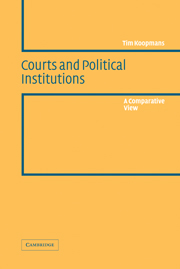Book contents
- Frontmatter
- Contents
- Preface
- Table of cases
- List of abbreviations
- 1 Introduction
- 2 The Sovereignty of Parliament
- 3 Judicial review of legislation
- 4 The growth of judicial power
- 5 The limits of judicial review
- 6 The legality of administrative action
- 7 Courts and governments
- 8 Courts and individual rights
- 9 Techniques of judicial protection
- 10 A glance at the future
- Select bibliography
- Index
10 - A glance at the future
Published online by Cambridge University Press: 26 February 2010
- Frontmatter
- Contents
- Preface
- Table of cases
- List of abbreviations
- 1 Introduction
- 2 The Sovereignty of Parliament
- 3 Judicial review of legislation
- 4 The growth of judicial power
- 5 The limits of judicial review
- 6 The legality of administrative action
- 7 Courts and governments
- 8 Courts and individual rights
- 9 Techniques of judicial protection
- 10 A glance at the future
- Select bibliography
- Index
Summary
The emergence of new problems
The main charm of the future is probably that we know so little about it. Consequently, we can speculate more freely than about the past and the present, without being hindered by inconvenient data that don't fit with our preconceived ideas. However, we shall also be treading on slippery ground: there are no accepted methods or techniques for drafting the world of the future. Extrapolating existing trends and developments is the most obvious way of arriving at some kind of certainty; but it is a poor method, as experience has taught us that one or more of these trends and developments will certainly be disrupted, or change their course, with the result that the ensuing image of a future situation may be completely mistaken. Predicting where changes will occur is more difficult still, as hundreds if not thousands of elements may influence future developments, some of which will be more stable than others. Winston Churchill must have been right when he said, in answer to a parliamentary question: ‘It is always wise to look ahead, but difficult to look further than you can see.’
However, since our research has shown us that the relationships between courts and political institutions are at present in a state of flux, it is tempting not to put a full stop to our inquiry at this point; it may be preferable to express the continuous movement of constitutional developments by a rapid glance at the near future.
- Type
- Chapter
- Information
- Courts and Political InstitutionsA Comparative View, pp. 252 - 284Publisher: Cambridge University PressPrint publication year: 2003

